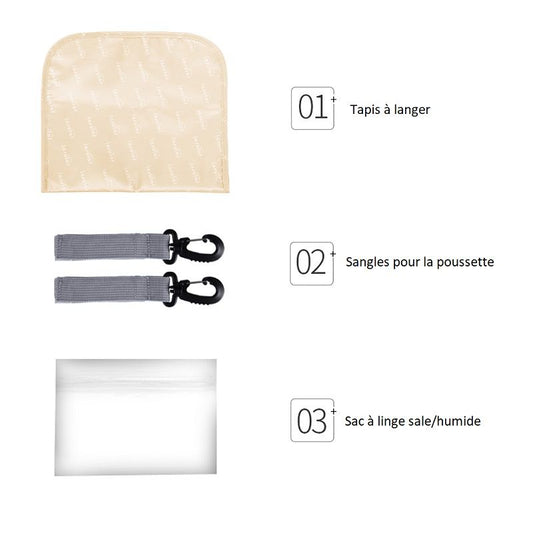When babies are two to three weeks old, I often hear these words from mothers: “My baby doesn't sleep at night. I'm so exhausted I feel like I'm going to die. » At this point in the conversation, I usually hold out the box of tissues.
Discover our Breast Pump collection.
When pregnant women go to bed at night, their babies tend to be very active. This phenomenon continues for a few weeks after delivery, resulting in a reversed day-night schedule. Babies initially sleep all day and eat all night, which can make life physically and emotionally exhausting.
Here are some important tips for surviving nighttime exhaustion:
First , enlist the help of your partner or another family member to take turns feeding the baby at night. If your spouse works regular business hours, remind him/her that caring for a newborn is the very definition of a full-time job, and that he/she now has a part-time job. Assign turns and work as a team to make sure everyone gets some sleep.
If you are breastfeeding, try to express some breast milk, so that at least one (or more) nightly feedings can be given by someone other than you. Keep in mind that bottles should not be offered until a good breastfeeding pattern is established. For some babies it takes a few days, but for others it may take several weeks. In my experience, easy-grip babies—those who enthusiastically grab at everything, including your elbow—may be given bottles sooner than hard-to-grip babies, usually within a few days of birth.
Why is difficulty gripping a problem? Unfortunately, some babies—especially those who have difficulty latching—reject the breast if they get a lot of bottles early on. It's not a pacifier mix-up, it's a pacifier choice. Babies are smart. They quickly learn that it is easier to get milk from a bottle compared to the breast, especially before milk is well established. If babies have difficulty latching and require supplementation, breast milk or formula can be given through a feeding syringe placed on a finger or on the mother's nipple, rather than through a bottle. Once a solid breastfeeding pattern is established, bottles can be offered safely and will not interfere with breastfeeding.
Second , it's never too early to begin sleep training, the process of teaching a baby to self-soothe and ultimately sleep through the night, even as young as one day old! In 1985, Dr. Richard Ferber published an essential book called "Solve Your Child's Sleep Problems," in which he formally described sleep training. Subsequent books have revised some of these recommendations, but I am convinced that Dr. Ferber was right from the start. Sleep training is essential for the long-term health, happiness and well-being of the family.
Sleep training is based on one principle—whatever condition is set when the baby first falls asleep will be needed to soothe the baby each time he wakes up. For example, if a baby falls asleep at the breast and is then placed in a crib or crib, he or she will eventually wake up and need the breast to go back to sleep. Unfortunately for tired caregivers, babies wake up throughout the night. The phrase “sleep like a baby” was probably written by someone who knew nothing about real babies. Although sleep training can begin immediately, it should be done gradually, as follows:
During the first week of life, whenever your baby seems sleepy and ready for a nap, try placing him in the crib or bed with his eyes open. If your baby falls asleep while eating, wake him gently (by changing his diaper or tickling his feet, for example) after he is full. His eyes should be open, at least a little, before putting him down. Your baby may have to cry or fuss to fall asleep. Let him do it. Crying is a way for a baby to relax before going to sleep. Additionally, studies have shown that letting your baby "cry it out" will not cause any psychological harm to the baby (only to the parents!).
Do not rock your baby to sleep. Rocking sets a bad precedent because you're doing all the work for the baby. The less help a child receives, the better. If you don't give your child the chance to develop self-soothing skills, he won't.
Some child-rearing texts recommend sleep aids such as tight swaddling, white noise machines (which can damage a baby's ears), and swings to simulate uterine conditions. In my opinion, this is a flawed approach to sleep issues and child rearing in general.
Remember, the best sleeper is a child who only needs their own body to fall asleep. Plus, life is much easier in the long run when a baby adapts to the family's lifestyle, rather than the other way around.
When parents set clear expectations and boundaries, babies rise to the challenge, especially when it comes to establishing good sleep habits. This principle is true for children of all ages.
Which raises another important point. To be effective parents, adults must take charge and establish ground rules; otherwise, the baby will be in charge, which is not a pleasant way to live. From my experience, I can assure you that a family's quality of life drops significantly when they raise a bully (see the blog post titled "How Not to Raise a Bully"). Sleep training is just one example—and probably the most important example—of an area where parents should set rules and try to stick to them.
Notice I used the word “try.” We are not robots, and it is not possible to be rigid all the time. Circumstances will sometimes require giving in to an unhappy and crying child, and that's okay.
Third , despite your best efforts, your baby will likely use the bottle or breast, to some extent, to fall asleep. Eventually, you will need to separate the process of eating and sleeping. Generally, this is done around two to three months. When you think about it, adults don't need to eat to fall asleep (most, anyway)—and kids shouldn't either.
To separate feeding from sleeping, your baby's last meal of the day should be given at least 45-60 minutes before bedtime, in a well-lit room with plenty of distractions. After the meal, engage the baby in stimulating activities, such as taking a bath or reading a book. At bedtime, place your baby in the crib without offering the breast or bottle. Then leave the room, give the baby a chance to fall asleep, and try not to interact until the next meal. For a two-month-old baby, the next meal could reasonably be two hours later. A four-month-old baby, on the other hand, is physiologically capable of sleeping through the night without eating for eight to ten hours. Although your baby may cry at bedtime, and it may be difficult to listen to those cries, resist the urge to pick her up. Remember, you're giving him the opportunity to develop self-soothing skills, a crucial investment in your family's sleep future.
The process of separating eating and sleeping can begin early. Various sources recommend sleep training at three months, but in my opinion it should start much earlier. For example, when my third daughter was five weeks old, I was desperately tired. One night I looked at her pretty little face (good thing she was so cute!) and said, "You need to sleep through the night or mom is NOT going to survive." » An hour after her last meal, I put my youngest in her crib and left. After 20 minutes of crying, she fell asleep, and that was that. She didn't wake up until 5 a.m.—morning time! Nearly 10 years later, she is still a great sleeper.
Unfortunately, not all children are equally trainable. With my second daughter, I made the mistake of waiting until she was five months old to begin the same process. The first night of this wonderful experience, my stubborn child screamed for three hours. To deal with the incessant screaming, I was forced to use earplugs (my mother told me she used to walk laps of our yard when she had me do sleep training). The second night she fussed for 20 minutes, and after that she stopped crying at bedtime. The good news is that sleep training usually only takes a few days to complete and quickly gets easier. Keep in mind that even with successful sleep training, some children will continue to cry themselves to sleep for months. Although frustrating, this type of agitation is harmless. Babies often need to cry to tire themselves out enough to fall asleep.
When I tell these stories in my office, parents often ask, “How long should I let my baby cry?” » The answer is always the same—until she falls asleep (note: this principle does not apply to babies with tetralogy of Fallot, a heart condition where crying can cause hypoxia, but for healthy babies, it's safe). For sleep training to work, 100% follow-through is essential. If a baby cries for an hour and then is picked up, the only thing the baby has learned is that lots of fuss gets attention. As Yoda once said, “You must unlearn what you have learned.” » A baby must learn that when placed in the crib, it is his job to sleep until morning. When parents enter and leave a crying baby's room, they send mixed messages and can potentially cause anxiety. Bedtime should be unambiguous.
One last point. If parents know from the start that they won't be able to do sleep training, I generally recommend waiting and not attempting it until they are ready.
For more advice on raising children, visit this site .

























































